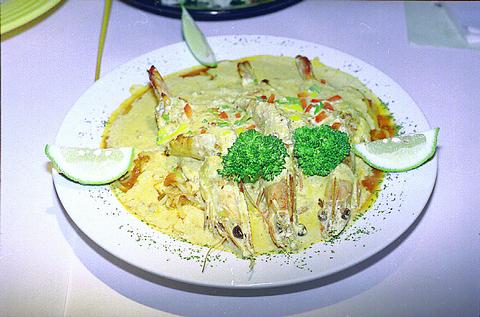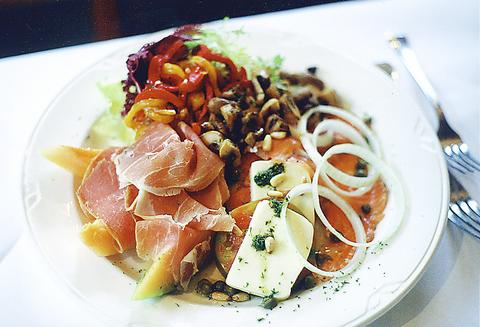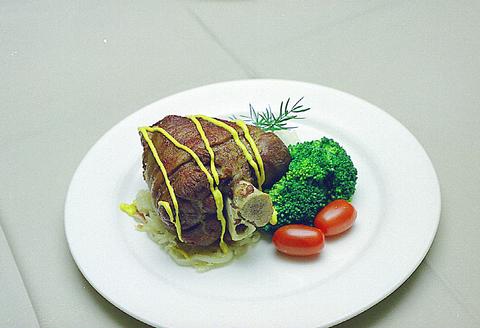Arcadia (拱門)
11, Lane 49, Anho Rd., Sec. 1, Taipei (北市安和路一段49巷11號), tel:(02)2781-0773, 2781-0285/6. Open:11:30am-2:30pm, 5:30pm-11pm (afternoon tea also served); Average meal:NT$500; English menu, credit cards accepted.
Arcadia has the look of a designer's studio, so it is hardly surprising that its owner, an interior designer uses it as a showcase.

PHOTO: IAN BARTHOLOMEW
The qualities that mark the decor can also be found in the food -- fine ingredients served in simple preparations. Presentation goes for lovely abstract designs, making use of colors to give the food added appeal.
Nelson Sy (施尼順), the restaurant's manager, has drawn on wide experience in Taipei's hotels and restaurants to develop a well-rounded menu, a mix of simple dishes such as eggplant gratin to a wide range of steaks and surf n' turf dishes. For lunch, Arcadia uses a semi-buffet format in which only the main course is served from the kitchen.
The snail gratin is a fine example of Arcadia's style, with six snails in butter, and a few herbs added for fragrance. Breaking the thin baked crust, the tastes of the oil and the snails are allowed to speak for themselves and make an excellent accompaniment to bread.

PHOTO: MAX WOODWORTH
For the main course, Sy said the pork knuckle with mustard and the lamb chop are both very popular. The knuckle, which is first steamed for several hours before being lightly baked, is incredibly tender, but long steaming has sweated out most of the fat. Served on the bone with a selection of steamed vegetables, garnished with sauerkraut and a little mustard, each element adds to a delicious and complex whole.
The lamb chop, which is in fact a mini rack of lamb, is served with pesto and a mint-flavored gravy. The restaurant remains open through the afternoon, serving excellent coffee and sweets.
The Stinking Rose (裝蒜餐廳)

PHOTO: IAN BARTHOLOMEW
342 Fuhsing N. Rd., Taipei (北市復興北路342號), tel:(02)2516-8880. Open:11:30am-midnight; Average meal:NT$600, business lunch NT$280; English menu; credit cards accepted.
Garlic has gotten a lot of good press in the last few years, listed along with olive oil as promoting longevity and preventing all manner of diseases. Taipei's Stinking Rose, under general manager James Wang (王資政), serves what he describes as "garlic cuisine."
Whether it's just a hint of garlic in the seafood combo -- a soup of salmon, cod and clams, prawns and more -- to the full garlic blast of its garlic spread (which accompanies the home-baked bread to the table), the scope of garlic -- and other -- flavors is truly extensive.
The restaurant's special, a crucial part of any garlic dinner, is the bagna calda, a kind of garlic hotpot. Cloves of garlic are served in a small copper saucepan, sitting in a pool of olive oil. The cloves are already very soft and can be applied like a spread to the homemade bread. The sharpness has been cooked out, and all that remains is a creamy sweetness that is as delicious as it is unexpected.
Most representative of the restaurant's style, according to Wang, are its pasta dishes. The garlic prawns with tagliatelle is a sumptuous mixture of tomato, cream and garlic mixed into a prawn stock. The tender flesh of the giant prawns can be easily removed from the shell with a knife and fork, as they have been considerately split down the middle, and each bite of the pasta is heavy with prawn and garlic flavors.
A more conventional choice is The Slab, a 14oz piece of US prime topped with bagna calda garlic cloves, which make a creamy accompaniment to the meat. This dish also comes with another of the restaurant's specials, bulbs of garlic roasted in the skin, which offers a concentrated garlic taste to set the taste buds tingling. The restaurant stays open throughout the afternoon during which customers can chose from reasonably priced set menus or the full dinner menu.
Garden Italian Restaurant (庭園義大利餐廳)
9 Sec. 2, Tunhua S. Rd., Taipei (北市敦化南路二段9號); tel:2784-4811. Open:12:30pm-2am (10pm on Sundays); Average meal:NT$700; English menu; credit cards accepted.
Clearly one of the main draws of Garden Italian Restaurant is its unusually late closing time at 2am. But the restaurant boasts other virtues that should attract people at any time of the day.
With a kitchen manned by a chef spirited away from the Hong Kong Hyatt, Garden offers a classic Italian menu of soups, seafood, meat and pasta dishes and pizzas. A good way to begin a meal with several people is the antipasti misto, which puts on one plate paper-thin portions of succulent Parma ham across fresh melons, rich slices of salmon, marinated tomatoes, roasted mushrooms, tomato mozzarella with pesto sauce and mixed garden greens.
Those who prefer to begin with a warm dish should try the seafood soup, which has a rich tomato base flavored with fresh basil and hearty chunks of squid, scallops, shrimps and clams. Indeed, many of Garden's specialties contain seafood. The friendly supervisor David Karami highly recommends the spaghetti with ink sauce, which he says always raises eyebrows for its unique taste and appearance. Colored with octopus ink, this rich, slightly salty sauce turns a plate of spaghetti midnight blue. Don't be put off by the color, the first bite of octopus and spaghetti will win over the pickiest of gourmets. Another outstanding dish is the osso buco served with crispy Italian saffron rice and a small garnish of broccoli. Save the marrow for last after eating the hearty portions of meat.
For dessert, indulge in the restaurant's tiramisu, which is creamy and not too sweet, and a hard-hitting cup of coffee.

In the March 9 edition of the Taipei Times a piece by Ninon Godefroy ran with the headine “The quiet, gentle rhythm of Taiwan.” It started with the line “Taiwan is a small, humble place. There is no Eiffel Tower, no pyramids — no singular attraction that draws the world’s attention.” I laughed out loud at that. This was out of no disrespect for the author or the piece, which made some interesting analogies and good points about how both Din Tai Fung’s and Taiwan Semiconductor Manufacturing Co’s (TSMC, 台積電) meticulous attention to detail and quality are not quite up to

April 21 to April 27 Hsieh Er’s (謝娥) political fortunes were rising fast after she got out of jail and joined the Chinese Nationalist Party (KMT) in December 1945. Not only did she hold key positions in various committees, she was elected the only woman on the Taipei City Council and headed to Nanjing in 1946 as the sole Taiwanese female representative to the National Constituent Assembly. With the support of first lady Soong May-ling (宋美齡), she started the Taipei Women’s Association and Taiwan Provincial Women’s Association, where she

Chinese Nationalist Party (KMT) Chairman Eric Chu (朱立倫) hatched a bold plan to charge forward and seize the initiative when he held a protest in front of the Taipei City Prosecutors’ Office. Though risky, because illegal, its success would help tackle at least six problems facing both himself and the KMT. What he did not see coming was Taipei Mayor Chiang Wan-an (將萬安) tripping him up out of the gate. In spite of Chu being the most consequential and successful KMT chairman since the early 2010s — arguably saving the party from financial ruin and restoring its electoral viability —

It is one of the more remarkable facts of Taiwan history that it was never occupied or claimed by any of the numerous kingdoms of southern China — Han or otherwise — that lay just across the water from it. None of their brilliant ministers ever discovered that Taiwan was a “core interest” of the state whose annexation was “inevitable.” As Paul Kua notes in an excellent monograph laying out how the Portuguese gave Taiwan the name “Formosa,” the first Europeans to express an interest in occupying Taiwan were the Spanish. Tonio Andrade in his seminal work, How Taiwan Became Chinese,